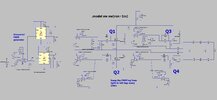Hi,
Why is the sinusoidal mains inverter said to be so difficult to design?
The attached LTspice does it no problem..
There is no need even to adjust the amplitude of the reference sine wave.
If you change the load on the output, it automatically changes the sinusoidal current to suit it...and puts the same sine voltage across it.
All open loop!
Why is this said to be so difficult?
(Not Grid_tied here, of course)
Generating the ref sine signal....i'd say this is best done by a mini LLC converter, wouldnt you agree?....tap off the sine with a current transformer, and use that as the ref sine? Big L and C values for 50Hz sine, but low current. AYK, its a train of half-sines thats actually needed (rectified sine)
As you know, when the load is purely a resistor of constant value, then the simple inverter principle above applies, but when there is rapid load changing , or non linear loads, then we need a control algorithm to be added.
Though the below appears to be the only chipset available to do this quickly. Do you know of any others?
https://www.ti.com/lit/ug/tiduay6e/...185&ref_url=https%3A%2F%2Fwww.edaboard.com%2F
Why is the sinusoidal mains inverter said to be so difficult to design?
The attached LTspice does it no problem..
There is no need even to adjust the amplitude of the reference sine wave.
If you change the load on the output, it automatically changes the sinusoidal current to suit it...and puts the same sine voltage across it.
All open loop!
Why is this said to be so difficult?
(Not Grid_tied here, of course)
Generating the ref sine signal....i'd say this is best done by a mini LLC converter, wouldnt you agree?....tap off the sine with a current transformer, and use that as the ref sine? Big L and C values for 50Hz sine, but low current. AYK, its a train of half-sines thats actually needed (rectified sine)
As you know, when the load is purely a resistor of constant value, then the simple inverter principle above applies, but when there is rapid load changing , or non linear loads, then we need a control algorithm to be added.
Though the below appears to be the only chipset available to do this quickly. Do you know of any others?
https://www.ti.com/lit/ug/tiduay6e/...185&ref_url=https%3A%2F%2Fwww.edaboard.com%2F
Attachments
Last edited:


